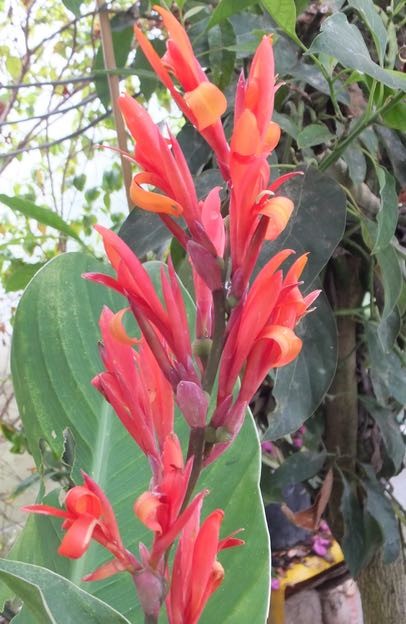
Indian Shot or Cannas are happiest in frost free greenhouses or a conservatory, they can even go outside all summer. But their lush foliage and incandescent blooms look better for longer under cover where their tropical appearance also seems more appropriate.
Found in almost all frost free parts of the world the Cannas are possibly one of the oldest flowers used ornamentally and became incredibly popular in Victorian hothouses. They grew many score species whereas now few can be found, replaced by a variety of improved hybrids.
Not quite hardy with their large leaves these rather obvious relations of bananas and Strelitzia retain an aura of tropical splendour. And though preferring a large root run in the border these can be cultivated in large tubs moved as required to make the most of their luxuriant leaves and sharp bright blooms. Indeed I prefer the older smaller flowered versions as some larger flowered hybrids are too garish, a bit overdone rather as Gladioli and Dahlias became.
You can start Indian Shot from seed, plenty is produced and it’s easy to handle- looks like the lead shot used in old guns thus the name. However only the aficionado would grow from seed when so much more impressive are available and then easily multiplied, some with coloured foliage as well.
Canna rhizomes can be divided in early spring and grown on in warmth. Their tubs should be large, heavy to balance the top growth, and filled with a free draining, sandy leaf-mould enriched compost. Rain water is preferable, with regular liquid feeding, and the plants like to be kept moist all the growing season then drying down into winter. Keep the rhizomes from frost and total drying out till re-starting in spring. Slugs and snails are a common problem otherwise Cannas are robust trouble free plants.
Cannas have some economic value, they’ve long been used as a foodstuff as their rhizome tubers are easily shredded and converted into starch. C. achiras, coccinea & glauca species are still grown on a small scale throughout the Tropics. C. edulis has the larger tubers and is considered the hardiest of these arrowroot Cannas. The starch (Queensland arrowroot, ker-gawl, gruya, achira, and tous-les-mois) still used as food for invalids and a glutinous thickener in sauces, is often commercially replaced by maize starch or corn-flour.


